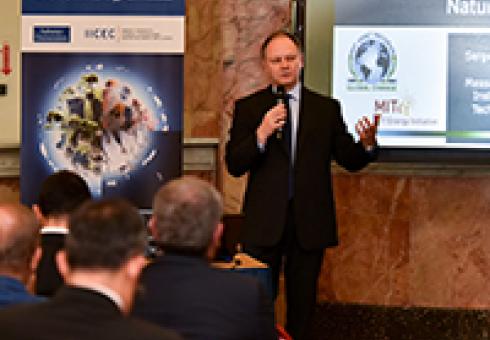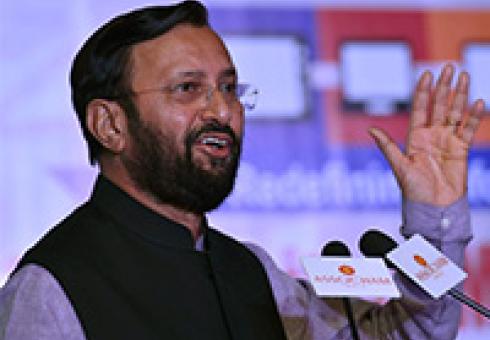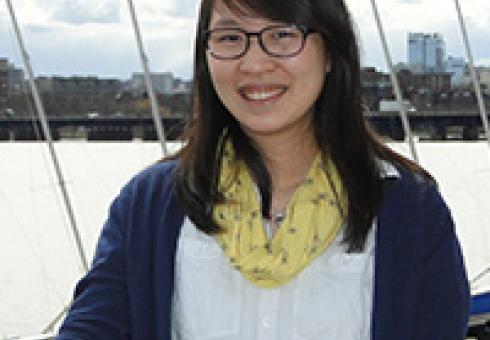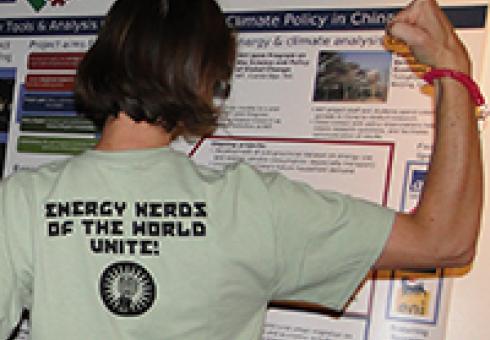News Releases
Proposal takes aim at Rwanda's air pollution
Mark Dwortzan | MIT Joint Program on the Science and Policy of Global Change
Climate CoLab, an MIT-based crowdsourcing platform to advance climate change solutions through the power of collective intelligence, has named Langley DeWitt, a research scientist with the Center for Global Change Science, as a Judges’ Choice winner in one of 15 contests for 2015. DeWitt, who is also chief scientist of the Rwanda Climate Observatory, was recognized in the Transportation contest for her proposal to set up an inexpensive air quality sensor network in Kigali, Rwanda as part of an effort to reduce vehicular emissions and improve air quality.
DeWitt and other contest winners will present their ideas at MIT's Solve and Crowds & Climate conferences, October 5 and 6 on the MIT campus, where the $10,000 Grand Prize will be awarded.
Read more about DeWitt's proposal here.
Mark Dwortzan
MIT Joint Program on the Science and Policy of Global Change
MIT researchers find unintended consequences
Like the leaves of New England maples, phytoplankton, the microalgae at the base of most oceanic food webs, photosynthesize when exposed to sunlight. In the process, they absorb carbon dioxide from the atmosphere, converting it to carbohydrates and oxygen. Many phytoplankton species also release dimethyl sulfide (DMS) into the atmosphere, where it forms sulfate aerosols, which can directly reflect sunlight or increase cloud cover and reflectivity, resulting in a cooling effect. The ability of phytoplankton to draw planet-warming CO2 from the atmosphere and produce aerosols that promote further cooling has made ocean fertilization—through massive dispersal of iron sulfite and other nutrients that stimulate phytoplankton growth—an attractive geoengineering method to reduce global warming.
But undesirable climate impacts could result from such a large-scale operation, which would significantly increase DMS emissions. The primary source of sulfate aerosol over much of the Earth’s surface, DMS plays a key role in the global climate system. In a study published in Nature’s Scientific Reports, MIT researchers found that enhanced DMS emissions, while offsetting greenhouse gas-induced warming across most of the world, would induce changes in rainfall patterns that could adversely impact water resources and livelihoods in some regions.
“Discussions of geoengineering are gaining ground recently, so it’s important to understand any unintended consequences,” says study co-author Chien Wang, a senior research scientist at MIT’s Center for Global Change Science and the Department of Earth, Atmospheric, and Planetary Sciences. “Our work is the first in-depth analysis of ocean fertilization that has highlighted the potential danger of impacting rainfall adversely.”
To investigate the impact of enhanced DMS emissions on global surface temperature and precipitation, the researchers used one of the global climate models that the Intergovernmental Panel on Climate Change (IPCC) uses, which simulates the evolution of and interactions among the ocean, atmosphere and land masses. Running simulations that compared two scenarios—one, known as RCP4.5, that the IPCC uses to project greenhouse gas concentrations, aerosol emissions and land use change based on policies that lead to moderate mitigation of greenhouse gas emissions over the course of the 21st century; the other identical to RCP4.5 except DMS emissions from the ocean were increased to the maximum feasible levels (about 2.5 times higher)—they found mixed results.
The simulations showed that enhanced DMS emissions would reduce the increase in average global surface temperature to half that of the RCP4.5 scenario, resulting in a net increase of 1.2° Celsius by 2100. But the cost would be a substantial reduction in precipitation for some regions.
“Generally, our results suggest that the cooling effect associated with enhanced DMS emissions would offset warming across the globe, especially in the Arctic,” says the study’s first author Benjamin Grandey, a senior postdoctoral associate in Wang’s group who configured the model simulations and analyzed the data. “Precipitation would also decline worldwide, and some parts of the world would be worse off. Europe, the Horn of Africa, and Pakistan may receive less rainfall than they have historically.”
Grandey and Wang warn that the lower rainfall could reduce water resources considerably, threatening the hydrological cycle, the environment and livelihoods in the affected regions.
The researchers hope their investigation—summarized in a video produced by Grandey—will inspire further studies of more realistic ocean fertilization scenarios, and of the potential impacts on marine ecosystems as well as human livelihoods. Further research will be needed, they say, to fully evaluate the viability of ocean fertilization as a geoengineering method to offset greenhouse gas-induced warming.
The study was funded by the Singapore National Research Foundation through the Singapore-MIT Alliance for Research and Technology Center for Environmental Sensing and Modeling, and grants from the National Science Foundation, Department of Energy, and Environmental Protection Agency.
Photo courtesy of Jacques Descloitres/NASA Goddard Space Flight Center.
MIT graduate student studies how a new UN treaty could affect mercury emissions from coal power plants in Asia
The Minamata Convention on Mercury, adopted by the UN in 2013, aims to reduce global mercury pollution by setting limits on specific pollution sources and prohibiting new mercury mining. Certain aspects of the treaty are still under negotiation, for instance the convention gives nations the flexibility to create their own plans for reducing mercury emissions from some sources, like coal-fired power plants. How nations choose to address these emissions has the potential to have a big impact on global mercury pollution, since coal fired power plants are responsible for about a quarter of mercury emissions worldwide.
MIT Engineering Systems Division graduate student Amanda Giang, a research assistant in the MIT Joint Program on the Science and Policy of Global Change, co-authored a recent study published in the journal Environmental Science & Technology that evaluates different ways India and China might address coal-fired power plants. The research was supported in part by the National Science Foundation.
Q. Why study India and China?
A. Whatever China and India do to reduce their mercury emissions will have the biggest impact on future global mercury levels. China is currently estimated to emit about a third of global emissions, and India is the second largest source at 7 percent. These emissions come from a variety of activities—mining, cement production, metal smelting—but coal combustion for industry and electricity generation is one of the biggest sources in these countries, and this source is expected to grow as economies develop.
Mercury from power plants travels worldwide, but is also deposited in ecosystems close to where it is emitted. That means countries have a strong domestic incentive to decrease mercury emissions. That is, the benefits of reduced pollution will be most strongly felt where the cuts are made, in addition to at the global level. So, a strict emissions standard for coal-fired power plants will not just benefit other countries, it would benefit India and China domestically.
Q. How do you measure the treaty’s benefits?
A. We measure benefits as avoided future mercury emissions. So we compare what would have been emitted under current pollution control technologies to what would be emitted under a few different ways of achieving the requirements outlined in the Convention, either through stricter technology requirements, or system-wide changes in the energy system. There are many technologies that can reduce mercury pollution, some already widely in use. We also model how mercury emissions travel through the atmosphere and enter ecosystems under these different scenarios.
The decisions that Convention negotiators make about the stringency of the technology requirements for coal power plants will make a big difference in avoided emissions. Convention negotiators want to strike a balance between requiring strong pollution control and allowing flexibility for different countries’ economic and technical capacities. Through analysis of existing studies, policies, and interviews with Convention negotiators, we identify technologies that India and China would be likely to adopt if they were given a lot of flexibility. We find that putting these technologies in place avoids about 12 percent of current day emissions. Requiring stronger, but technologically feasible pollution control technologies avoids another 8 percent—an amount equivalent to India’s total present-day emissions.
Q. So far you’ve covered how to avoid increases in mercury pollution. Is there any way to actually decrease emissions?
A. Emissions-control technologies can slow emissions growth, but alone, they likely won’t keep total mercury emissions from growing as China and India consume more coal to fuel their energy needs. The most effective way to lower mercury emissions below present-day levels would be combining control technologies with a transition away from coal as a power source. Under a global transition to low-carbon energy sources, we could see a decrease in emissions from the power sector. In India though, where power sector growth is anticipated to meet energy access needs, we could still see an increase in emissions in the future despite control policies.
It’s important to keep in mind that whatever mercury is released into the environment now doesn’t stay where it’s deposited. Mercury that is deposited in the environment can easily cycle through the rest of the ecosystem for decades, ending up in the air, water, and land. So, whatever decisions are made about how to reduce mercury emissions now will continue to affect us in the future.
This research was supported in part by the National Science Foundation.
Read the study
Impacts of the Minamata Convention on mercury emissions and global deposition from coal-fired power generation in Asia
 |
||
|
|
Photo: Dara Entekhabi, courtesy of Len Rubenstein, MIT Spectrum |
by Audrey Resutek | MIT Joint Program on the Science and Policy of Global Change
On January 29, 2015, a Delta II rocket launched from Vandenberg Air Force Base will carry the SMAP Observatory, the first satellite designed exclusively to monitor soil moisture, into orbit. Once there, the satellite will make a map of the Earth’s soil moisture every three days—creating a measurement with the potential to dramatically improve weather forecasts and predictions of climate change.
It’s been a long journey to get to this point, as Prof. Dara Entekhabi, the science team leader of the NASA mission and a researcher at the Joint Program on the Science and Policy of Global Change, can attest. SMAP, which stands for Soil Moisture Active Passive, was first conceived in 1999. Over the last 15 years, Entekhabi has led a team of researchers at MIT and other universities, the NASA Jet Propulsion Laboratory, and the NASA Goddard Space Flight Center working on the satellite.
“The team has stuck together,” notes Entekhabi, who holds a joint appointment in MIT’s Department of Civil and Environmental Engineering and the Department of Earth, Atmospheric and Planetary Sciences. “It’s almost the same people as when we started working on SMAP.”
Once SMAP is in orbit it will measure moisture in the first five centimeters of the soil, using two instruments—active microwave radar and a passive microwave radiometer. The data transmitted back to Earth will represent a huge leap forward for scientists studying how the Earth works.
Unconventional Data
Entekhabi has spent his career learning about the Earth through collecting data, and the information collected by the SMAP Observatory will fill a major gap in our understanding.
“I was always into data and the environment, and reconstructing old records,” says Entekhabi. “I eventually became interested in creating new sources of data—unconventional data. Which is how I became involved with SMAP.”
SMAP is the first NASA mission dedicated to studying soil moisture and freeze/thaw data, which indicates the start and end of the growing season. Because of this, current records are spotty at best, and are based mostly on data from sparse ground stations and readings from satellites primarily designed for other uses.
 |
|
|
Photo: Artist's rendering of the SMAP spacecraft, courtesy of NASA/JPL. |
The mission is somewhat unusual, Entekhabi says, because the long development period gave the mission team time to cultivate a community of early data adopters, who have already developed applications for the data. The information produced by SMAP will be tailored to fit these users’ needs—allowing them to immediately put the data to use for forecasting and research.
“This is a path-breaking approach for NASA, because the applications are woven into the science of the mission. So, it’s broad basic research, as well as application,” says Entekhabi.
There is an impressive range of uses for soil moisture data. These include the obvious, like improving weather and climate forecasting; estimating agricultural productivity; tracking droughts, floods and landslides; to the less obvious, such as providing early warnings of famine in areas dependent on rain-fed crops; determining soil hardness on military transportation routes, and forecasting the density of the lower atmosphere, which determines how much lift an airplane has.
The lack of information about soil moisture is also a problem for basic Earth science research, because soil moisture links the three major cycles of the Earth system—the water, energy, and carbon cycles—together. Without accurate soil moisture data it’s nearly impossible to accurately trace the movement of water through these three systems.
“These are basically three gears that are locked together,” Entekhabi says. “If we don’t get this right in models, because we don’t know what the linkage is, it’s a problem. Measuring soil moisture is important because it’s the pivot that links these three gears.”
 |
||
|
|
Photo: SMAP lowered into place, courtesy of NASA/JPL-Caltech. |
|
Understanding soil moisture will likely greatly improve the accuracy of weather forecasts at a fraction of the cost of other measures, like beefing up computing power to support higher resolution weather models. It will also improve how models estimate how climate change will affect precipitation, which, up until now, has been notoriously difficult to pin down.
“All the models agree on global temperature; you can’t get that wrong,” Entekhabi says. “But what’s going to happen with regional water availability, regional precipitation, the models don’t even agree in sign—some of them are positive, some of them are negative—let alone magnitude.”
Taking Extreme Weather’s Fingerprint
Entekhabi’s work on the water cycle and soil moisture spans decades, starting with his doctoral work at MIT, where he worked to improve how climate models account for land surface moisture. He joined MIT’s faculty in 1991 and has been involved with the Joint Program since its creation in the early 1990s.
“A major question in the field today is what is climate change going to do to the water cycle?” Entekhabi says. “The real challenge is predicting the future of water availability at a regional scale.“
To address this issue, Entekhabi worked with the Joint Program to create a new way of predicting how climate change will affect the frequency and severity of extreme precipitation. The method takes advantage of the fact that climate models do a good job of simulating the large-scale atmospheric events that lead to extreme precipitation, even though they’re bad at predicting the precipitation itself. The method bypasses climate models’ built-in precipitation parameterizations, and instead looks for the large-scale conditions that have been associated with extreme weather events in the past.
“What we’re doing is basically fingerprinting,” Entekhabi says. “We use the historical record to find a fingerprint, or pattern of what’s going on in the large-scale climate that causes extreme weather.
The technique, called an “analogue” method because it does not directly simulate precipitation within the model, gives more accurate reproductions of past extreme weather events than climate models alone. Once the patterns associated with extreme weather—either very wet or very dry—are identified, the next step is to look at future changes in these patterns in a climate model.
Entekhabi is currently working to identify these patterns across several regions. In one example, he studied over 100 years of precipitation data for the region around Mumbai, where the monsoon season can cause devastating floods in densely populated areas. The monsoons that caused the worst flooding left a distinct atmospheric fingerprint, he found.
“The fingerprint of the monsoon is much larger than the local flooding in Mumbai,” Entekhabi says. “The circulation patterns extends all the way to the Arabian Sea and the coast of East Africa. Basically a long arc of vapor from the Arabian Gulf gets blocked, and it just sits there and rains a lot.”
The method can be applied to any event in any region, as long as it is associated with changes in large-scale atmospheric conditions. Working with Dr. Adam Schlosser, a senior research scientist and assistant director for science research at the Joint Program, Entekhabi is currently applying the analogue method to West Africa, a region that relies on rain-fed agriculture for most of its food. Most of the rain in the region falls during a three-month rainy season in the summer, and what happens in the rainy season can make or break the area’s food supplies.
“Models will always be uncertain once you start looking into the future,” Entekhabi says. “SMAP is one way we’re trying to improve the quality of models—by looking at how the water and carbon cycles fit together. The analogue approach is another way of attacking the challenge of regional water availability from an entirely different angle.”
For now, Entekhabi is turning his attention skyward. In the Fall, Entekhabi traveled to Southern California, where SMAP was being loaded into a rocket at the Jet Propulsion Laboratory. He’ll remain there through the spring, while SMAP is being calibrated.
“It’s been a long trek,” Entekhabi says. “But every single screw on SMAP has been reviewed and reviewed and reviewed. Right now there’s no more testing, no more touching the satellite. There’s no looking back now.”
MIT researcher Sergey Paltsev discusses the outlook for LNG trading over the next several decades.
Until recently, most natural gas trade has been limited to the regional scale due to the challenges of transporting gas over long distances. Over the last decade, Liquefied Natural Gas (LNG)—an option that reduces the volume of gas about 600 times allowing for transportation by ship—has created an opportunity for expansion of the international market for natural gas.
In this report, Joint Program researchers examine the prospects for LNG trade over the coming decades. Part of a collaborative project between MIT and Cyprus, the report estimates that LNG trade volumes will increase from about 240 Mt LNG in 2014 to about 340–360 Mt LNG in 2021.
Sergey Paltsev, coauthor of the report and a principle research scientist and assistant director for economic research at the Joint Program, discusses some of the report’s findings.
Q. The increase in trade volumes is largely the result of new LNG infrastructure projects. What’s causing the upswing in construction?
A. The main force driving many of these new LNG projects is the high price of LNG in Asian markets. The cost of natural gas in the US right now is about $4/mmbtu. If you add in liquefaction and transportation costs it’s about $10-11, whereas Asian prices up until recently were $14-$16. So, with this price differential an LNG exporting operation can be quite profitable. Actually, the trend that we’re seeing with new LNG projects is the opposite of what we saw less than ten years ago. In 2005 and 2006, US companies were building regasification capacity, or in other words, terminals to get gas into the country. Now, a lot of infrastructure is sitting idle because US prices are so low. Many of the current U.S. projects are actually taking the existing import terminals and converting them into liquefaction facilities, or export terminals.
This underscores why long-term market analysis is so important. Since the development and construction periods of these projects are so long, 4-5 years on average, any projects started now are not going to ship gas until 2020; and those facilities are going to be operational for at least 20–30 years. So that means you need to understand the market dynamics not just today, and probably not just in 2020 when you start operation, but also in 2030, 2040, and 2050.
Q. Is the US going to become a major player in the LNG market?
A. There are a lot of projects that are in the permitting process right now. To export LNG from the US, you need approval from the DOE and the Federal Energy Regulatory Commission (FERC). If you add up all of the applications which are currently in the pipeline and those projects labeled by FERC as potential, the total is more than half of the US current natural gas production. Obviously many of these are not going to happen, but everyone is trying to capitalize now. There are currently only two US projects that are likely to be completed before 2020—the Sabine Pass and Corpus Christi projects run by Cheniere Energy, Inc. In comparison to the current very limited exports from the US, these two projects will substantially increase exports from the US. So the US will have some share of the LNG market, but I don’t see it becoming the dominant player.
Most of the exports from the US will likely go to Asia, and one thing to note is that the price of LNG in Asia will start to come down as shipments of LNG increase. Over the next ten years, the global price of LNG will equalize—in other words, the price will be the same in all regions, with the main difference being the cost of transportation. So, the price differential between the US and Asia is going to narrow.
Q. What’s the long-term prognosis? Have we entered a golden age of LNG trading?
A. LNG is poised for substantial increases. Looking at the supply side, the LNG market is going to expand. Suppliers who have traditionally been in the pipeline business, like Russia, are now actively pursuing LNG projects. Again, this growth is being driven by the high price of LNG in Asia, which isn’t going to last forever. So some of the hype is going to diminish, but even with a lower Asian price this mode of natural gas trade is still going to expand.
Future demand is harder to estimate because there’s more uncertainty there, especially when much of the future demand will be determined by carbon policies, especially in China and India. Developing countries are expected to dominate new demand, and this trend is likely to continue. In addition, the LNG technology keeps evolving. In our report we discuss the potential effects of floating LNG (FLNG)—ships that liquefy gas onboard. FLNG could have a substantial impact on the industry if proven viable, since it removes the need to build permanent infrastructure.
On Friday, October 17, 2014, CECP team participated in the MIT Energy Night at the MIT Museum between 6:00-9:00pm.
The MIT Energy Night provides an ideal opportunity to see what energy at MIT is all about and the CECP team presented two posters and interacted with hundreds of MIT students, faculty, energy companies, researchers and foreign business leaders.
See our posters and pictures below.













